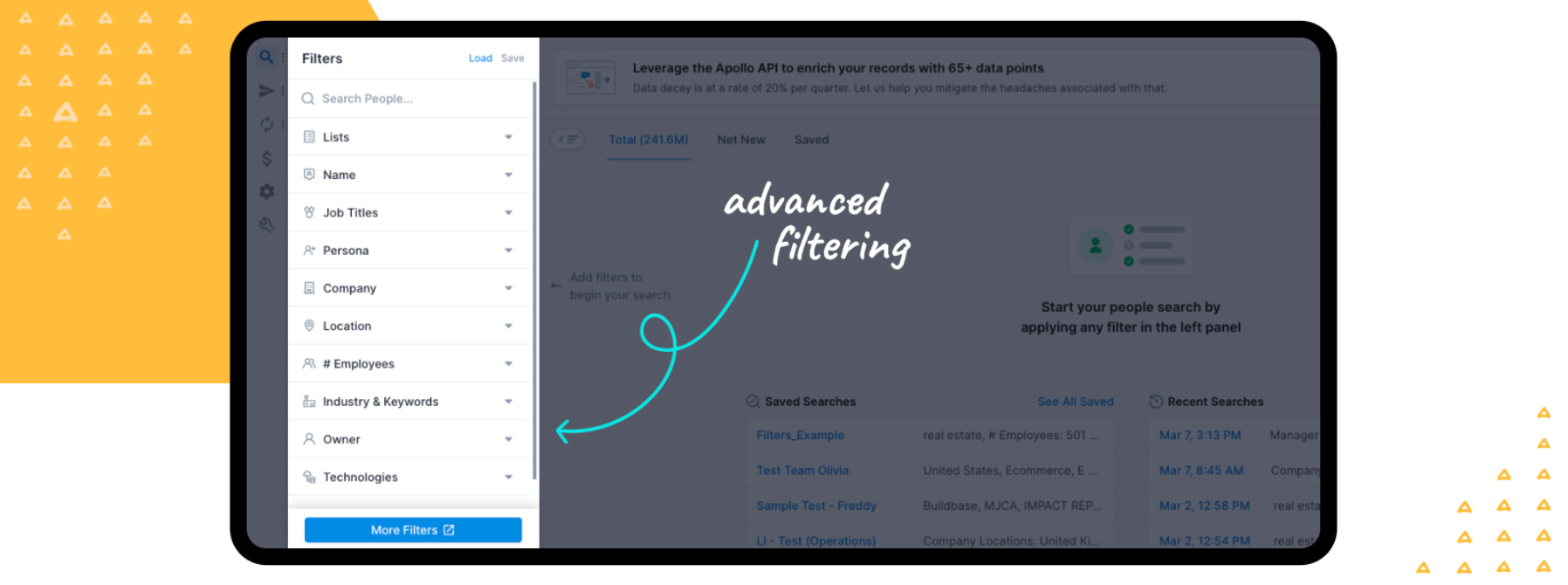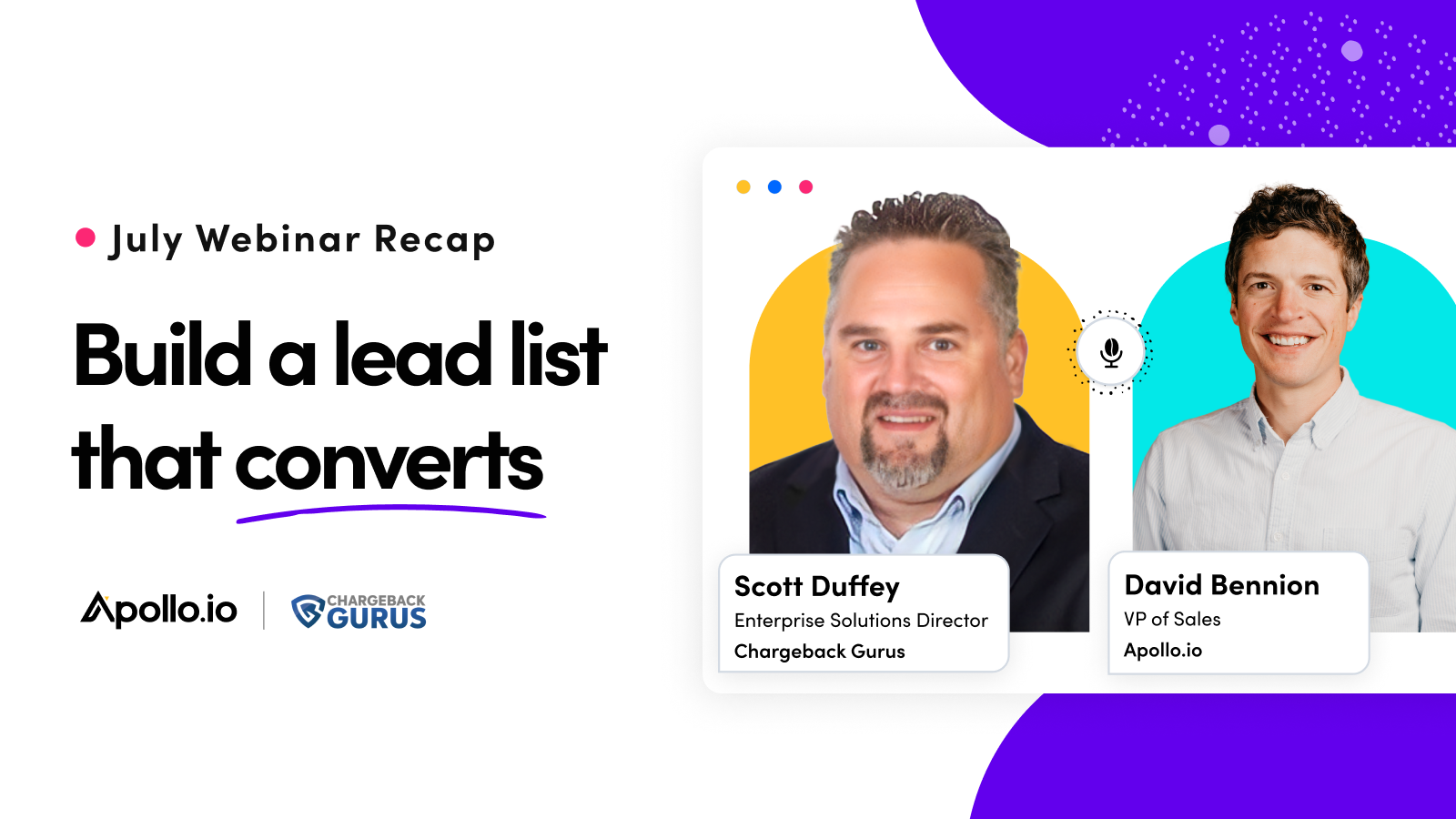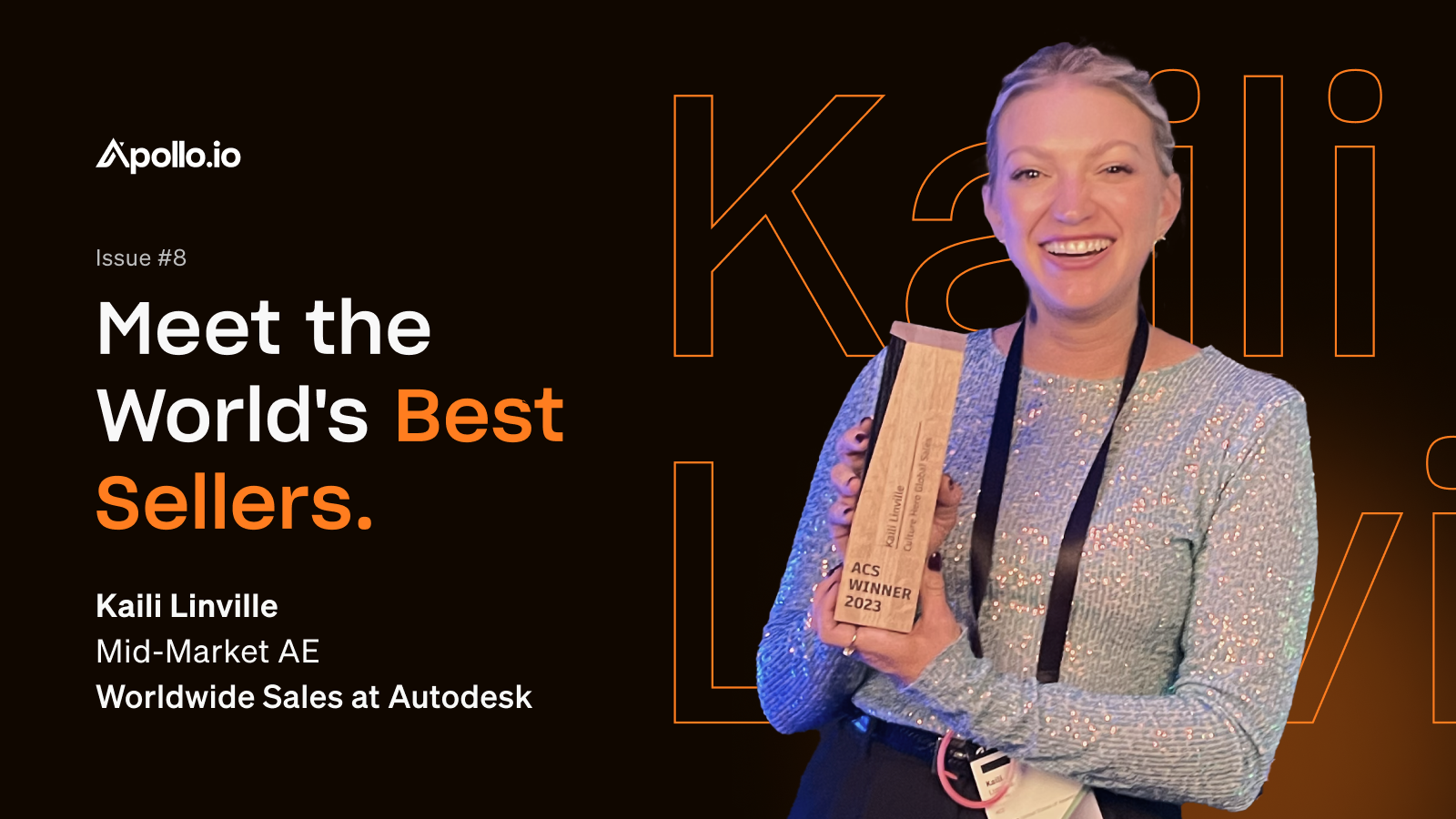Who are you going to reach out to today?
The answer should be on your highly-targeted B2B lead list; your list of best-fit contacts you can move through your sales funnel to become customers.
But, building out a fully-stocked lead list is easier said than done…
Too many sales teams waste time and leave money on the table by using lead lists that are inaccurate and out of date.
That’s why, in our July webinar, we invited sales experts Scott Duffey, Enterprise Solutions Director at Chargeback Gurus, and our very own VP of Sales, David Bennion, to share their tips and tricks for building a lead list that converts!
Below, we’ll recap the webinar and share their actionable advice for supercharging your prospecting process.
First, some context on Apollo
You’ll soon learn that Scott and David are big Apollo.io fans, especially when it comes to highly-targeted sales prospecting.
So, let’s start with a brief Apollo introduction….
What’s Apollo.io?
Apollo.io is the future of go-to-market. With Apollo, every seller, marketer, founder, and recruiter, can move business forward with more ease and less time wasted.
We equip B2B professionals with everything needed to make work clear, quick, and simple.
Our customers use Apollo to:
- Find every prospect. Uncover high intent contacts in your target market with our vast B2B database and advanced search filters.
- Connect with every contact. Create multi-step outbound sequences at scale, automate your emails and stay on top of the steps in your outbound prospecting process using our platform.
- Move business forward. Optimize your sales strategy by unlocking opportunities across your workflow.
With all of these functionalities, you better believe Apollo has tools for lead generation and list building! Keep reading to learn tips and tricks first-hand from the featured webinar’s expert sales professionals…
The challenges of list-building
Before jumping straight into actionable practices, Scott and David mentioned that one of the biggest obstacles to creating a list of best-fit leads is fully understanding and identifying your ideal customer profile (ICP).
“The most important thing for me when it comes to building a list is absolutely understanding who the right buying persona is for my service, [but] that’s also a big part of the challenge”, Scott admits.
And identifying that ICP is only half the battle…
Sales teams need to not only know who their buying personas are, but also their personas’ needs and pain points, their market, goals, etc. Only then can you create a list full of leads that you are ready and able to provide immediate value to and convert into happy customers.
How Apollo helps you build better lead lists
So how do you gain the insights you need to kickstart your list-building process? With an all-in-one sales intelligence engine of course!
In this next section of the webinar, Scott gave his best practices for using Apollo to build lead lists that exponentially grow your pipeline (and, your revenue!).
Find the right buyers with highly granular filtering
Only best-fit leads should enter your lead list. And, in Apollo, you have 65+ advanced filters to help you find them!
“What’s been nice in the time I’ve worked with Apollo is how adept the filtering functionality is within the service,” Scott says. “[The Apollo database] almost always captures exactly who you’re looking for…and it’s those people that are the ones that you want to make sure that you save and create your list”.
As you create your lead list, you can tailor your Apollo searches using filters like:
- Title
- Company name
- Funding
- Technologies used
- # of employees and department headcount
- Revenue
- Alexa Rank
- Job postings
- And more!
These filters can be found by navigating to the Searcher where the filters sidebar will be on the left.

Applying filters that align with your company’s ICPs gives you a launching pad to create your most effective messaging and engagement strategy down the line!
Build automated Sequences for targeted engagement
Now that you have a beautiful lead list, it’s time to put it to use.
For this, Scott uses Sequences, Apollo’s must-have feature for creating automated outreach campaigns. “Getting more strategic with my lead list – for me – is being able to send out the right messaging through good sequencing”, he says.
Scott uses a smattering of templated emails, call tasks, and LinkedIn actions to engage his leads with the right messaging at every touchpoint.
Here is an example of one of Scott’s sequences that targets his buying personas in the travel and leisure industry:

This is a simple three-email, one-call sequence, scheduled over the course of a month; and it’s just one example of Scott’s many sequencing strategies to reach the contacts on his lead list.
And he isn’t alone…
In recent customer interviews, 75% of Apollo’s top power users said that sequences and sequencing automation are must-use features across their sales cadence.
Aside from providing you with hands-off engagement for your leads, Apollo Sequences also gives you:
- Institutionalized best practices for engaging leads into easy-to-follow guides that automatically add defined tasks to your Apollo dashboards on set schedules, which ensures consistency and accountability for your sales team.
- A/B testing for message templates, scripts, and strategies to confirm the best version of any step in your sales process.
- Reporting to compare and optimize your approach and help you to confirm the best times for every message you send.
- Detailed analytics that are specific to your messaging and sales activities, such as how many messages were delivered, opened, replied to, and bounced.
Send the best message every time with templated emails
Another Apollo tool that Scott loves is email templates.
Email templates make it easy for you to share your best messages with each contact and they also allow your team to collaborate and share resources with ease.
Scott shared that it’s his practice to create templates that are unique to the vertical and the service he is selling, and then add them into his sequences, scheduled at just the right time.
Here is an example of a template Scott included in the email sequence above:

Enhanced with personalization snippets and value-based messaging, this is a beautiful example of strategic outreach at work!
“[Sequences and Templates] really increase your chances of not only connecting with the right person but connecting with them at a time when they are thinking about the topic at hand,” David concludes.
Other tips & tricks for creating an effective lead list strategy
- Send value-based initial touchpoints. Scott has a tried and true method for sending an initial email touchpoint: acknowledge their pain point, state your value, and make a request for further connection. Get inspired to write that first email with this example of Scott’s initial touchpoint template below:

- Leverage Apollo functionalities for external lists with CSV file uploads. One of Scott’s biggest prospecting success stories started with a simple CSV file upload into the Apollo platform. Targeting contacts at a large footwear distribution company, Scott created and uploaded a CSV file into Apollo and, once he had that list created, he could perform extensive filtering, update contact information, target his personas, etc.“From that, I received back significant responses of excitement,” Scott says. “Once I was able to launch engagement, my pipeline grew exponentially overnight!”
- Patience is key. It’s important to remember that, especially when you are dealing with your best-fit leads, success isn’t always immediate. It’s often a long term, relationship-based strategy that engages your leads with precise, targeted messaging. Be patient and focus on giving your prospects value that resonates with them over time.
Q&A summary
Our live audience asked some great questions that maybe you have, too! Check out the recap of the Q&A:
Question #1: How do salespeople identify the specific roles they want to reach?
“A first principle [is asking] who is this going to benefit, who’s going to find value in my solution, that’s your persona. It’s also really important to think ‘Who’s going to buy my solution?,” David answered. “There are people who are going to use [your product], and there are people who are going to buy it. You want to be able to resonate with both of those folks, but you need to know how to communicate with the decision-marker at the end of the day.”
David adds, “Also whether you have a product marketing team, or, if you’re a smaller organization, maybe it’s your CEO…[Ask them] ‘Who are we trying to solve problems for, what are their jobs, and how are we going to be helping them?”
Scott’s answer was similar. He encourages people to rely on team members who specialize in identifying your company’s ideal buyers, “Circle back to your leadership team or your marketing group and identify who’s best going to be able to utilize the product or service that you’re selling…who is going to benefit most from your product or service. So, [for example] in my case, it’s anybody that pays attention to revenue.”
Question #2: How long should an email sequence be?
Scott says, “Personally, I go for three. I send a first one, then an email a week later that’s much smaller than the first one, and then a couple weeks later I always pepper in a LinkedIn connection request…I also try to sprinkle in a call in the middle and at the end. So that’s around 6 efforts and 3 emails. [But] absolutely stretch it out to more than just one person at the company…you don’t know who is the contact who is going to get back to you.”
Question #3: What makes Apollo better and/or different from the competition?
David, as the VP of Sales at Apollo, jokingly admits he is a little biased, but goes on to give some of the reasons why Apollo prides itself as the world’s leading end-to-end sales solution.
“One of the reasons that makes us unique is our data set. It’s just the biggest, the most complete, the most up-to-date, making it the most accurate”, he says, “For example, we share when and where people change jobs…it’s a singular feature, but it really is a feature of a bigger solution which is data that makes you as efficient as possible. Another differentiating factor [for Apollo] is our ease of use…Some of the solutions that you see in the market today are pretty heavy to set up and get started. Apollo’s mission is to make go-to-market simple and accessible for all.”
As a daily user himself, Scott couldn’t wait to chime in on this one, “Another big thing for me, is its affordability for a great solution…[Chargeback Gurus] have looked at other services, and we feel that the value we get for the price point, as well as the service, is far and away over somebody else,” Scott says. “On top of that, Apollo has so much functionality built in and they are constantly rolling out new things!”
Question #4: What is the 1-2 sentence summary of building a lead list that converts?
David summarized it beautifully, “Know your industry, the accounts and the personas that you want to reach out to and build your list based off of those filters. And if you can get more granular form there, you’ll do even better.”
In Closing
Apollo is proud to share the voices of users, just like you, whose best practices are proven to take sales results to the next level!
Not an Apollo user? Worry not! Sign up for free and start using Scott’s lead generation methods today. And don’t forget to follow Apollo on LinkedIn and Twitter to never miss out on future Apollo webinars, events, and sales insights.





